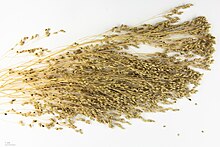| Proso millet | |
|---|---|

| |
| Proso millet panicles | |
| Scientific classification | |
| Kingdom: | Plantae |
| Clade: | Tracheophytes |
| Clade: | Angiosperms |
| Clade: | Monocots |
| Clade: | Commelinids |
| Order: | Poales |
| Family: | Poaceae |
| Subfamily: | Panicoideae |
| Genus: | Panicum |
| Species: | P. miliaceum
|
| Binomial name | |
| Panicum miliaceum | |
| Synonyms[1] | |
| |

Panicum miliaceum is a grain crop with many common names, including proso millet, broomcorn millet, common millet, hog millet, Kashfi millet, red millet, and white millet.[2] Archaeobotanical evidence suggests millet was first domesticated about 10,000 BP in Northern China.[3] Major cultivated areas include Northern China, Himachal Pradesh of India,[4] Nepal, Russia, Ukraine, Belarus, the Middle East, Turkey, Romania, and the Great Plains states of the United States.[5] About 500,000 acres (200,000 hectares) are grown each year.[6][better source needed] The crop is notable both for its extremely short lifecycle, with some varieties producing grain only 60 days after planting,[7] and its low water requirements, producing grain more efficiently per unit of moisture than any other grain species tested.[7][8] The name "proso millet" comes from the pan-Slavic general and generic name for millet (Serbo-Croatian: proso/просо, Czech: proso, Polish: proso, Russian: просо).
Proso millet is a relative of foxtail millet, pearl millet, maize, and sorghum within the grass subfamily Panicoideae. While all of these crops use C4 photosynthesis, the others all employ the NADP-ME as their primary carbon shuttle pathway, while the primary C4 carbon shuttle in proso millet is the NAD-ME pathway.
- ^ "Panicum miliaceum L.". The Plant List. 2013. Retrieved 8 January 2015.
- ^ "Panicum miliaceum". Germplasm Resources Information Network. Agricultural Research Service, United States Department of Agriculture. Retrieved 8 January 2015.
- ^ Lu, H.; Zhang, J.; Liu, K.-b.; et al. (21 April 2009). "Earliest domestication of common millet (Panicum miliaceum) in East Asia extended to 10,000 years ago". Proceedings of the National Academy of Sciences. 106 (18): 7367–7372. Bibcode:2009PNAS..106.7367L. doi:10.1073/pnas.0900158106. PMC 2678631. PMID 19383791.
- ^ Bhat, B Venkatesh; Arunachalam, A; Kumar, Dinesh; Tonapi, Vilas A; Mohapatra, Trilochan (2019). Millets in the Himalaya (PDF). Indian Council of Agriculgultural Research. pp. 28, 76. Archived from the original (PDF) on 2022-02-25.
- ^ Cite error: The named reference
2017 reviewwas invoked but never defined (see the help page). - ^ "USDA - National Agricultural Statistics Service Homepage".
- ^ a b Graybosch, R. A.; Baltensperger, D. D. (February 2009). "Evaluation of the waxy endosperm trait in proso millet". Plant Breeding. 128 (1): 70–73. doi:10.1111/j.1439-0523.2008.01511.x.
- ^ Lyman James Briggs; Homer LeRoy Shantz (1913). The water requirement of plants. Govt. Print. Off. pp. 29–.